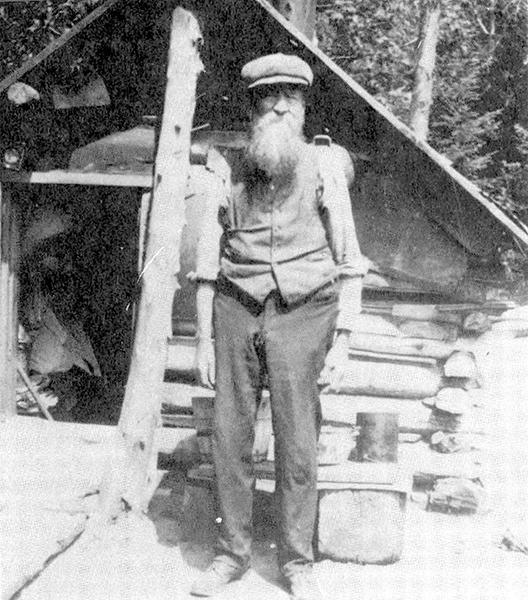Speaking of hermits, we’ve met Cummings, the Wild Man of Oliphant, who had a shanty of logs and driftwood out in the Fishing Islands at the end of the 19th century. He survived on his island in Lake Huron by fishing and by forays ashore to help himself to farmers’ chickens and seed potatoes. The Wild Man scared the bejeebers out of more than one farmer’s wife by entering a farm house and demanding food. (He spent some winters in Walkerton jail for stealing food.)
Was Cummings the only hermit in Bruce County? What about Robert Bruce, who had a small cabin just over the border in Grey County, two miles northeast of Wiarton? He gave his name to a famous cave on his property, Bruce’s Cave.
I do wonder, though, if Robert Bruce qualifies as a hermit since, according to his obituary in the Walkerton Telescope of Feb. 6, 1908, he spent summers working for the Grand Trunk Railway and winters in his cabin. Actually, his real name was Robert Gilchrist and he was by no means penniless. After his death at age 84, two nieces in the Orkney Islands, Scotland, laid claim to his estate, valued at $2,400 (Chesley Enterprise, May 7, 1908).
Nevertheless, tourism articles repeat the story of “the hermit of Bruce’s Cave” – born in the Orkneys, served in the Scots Guards, deserted in 1854 at the start of the Crimean War, fled to Canada, settled on 300 acres overlooking Colpoy’s Bay, lived in Bruce’s Cave (not true), and charged admission to tourists curious about the cave.
Southampton, on the other hand, does have a genuine hermit in its history. He was located by Marvin Doran of Southampton (and secretary of the Bruce County Historical Society). Marvin had always heard stories about a hermit who used to live in the woods by South Street. He went searching, and found him. His report is in the April 2023 newsletter of the Historical Society.
First, Marvin found an obituary in the Southampton Beacon of March 18, 1920: “John Collins, an old watch repairer, who came to the House of Refuge at Walkerton about six months ago from Southampton, passed away on Monday last from pneumonia, aged 85 years. The deceased, who was a bachelor and a confirmed recluse, was familiarly known as ‘John, the Hermit,’ owing to his peculiar habit of dwelling alone in a small shanty in the woods for many years.”
Marvin also checked the Historical Society’s 1982 Yearbook and found Howard Krug’s appeal for information about the man in the picture, a photo of a bearded gentleman standing before a small log cabin partially sunk into the ground. Howard wrote, “Around 1914 and 1915 this man lived alone in the little log cabin in the background of the picture, near Miramichi Bay south of Southampton. His first name was John but he was generally known as the ‘Hermit.’ He was not an eccentric and was not averse to visitors. Joe Vandrick, who worked in the bank at Southampton at that time, told me that he and others used to go out and split wood for him.”
A final source was the history of Saugeen Township, Roots and Branches of Saugeen, 1854–1984. The Douglass family visited Mr. Collins in 1916-17 and took photos. “The cabin of Old John, the hermit, was in the bush just a little south of South Street at the southern edge of Southampton, about 1/4 mile in from the lake shore.”
Marvin explored the woods near South Street and found remains of an old log cabin. It was sunk into the ground, about six feet down. He concluded, “We know the hermit existed, where he possibly lived and where he died. But we don’t know where he came from, who his family were, etc. It would be interesting to know.”
How did Marvin Doran find his hermit? By reading old newspapers and BCHS Yearbooks online. You can too, by going to the Bruce County Museum & Cultural Centre’s online repository, at newspapers.brucemuseum.ca. Another resource for those researching Bruce County history is the PastPerfect database, at brucemuseum.pastperfectonline.com.



